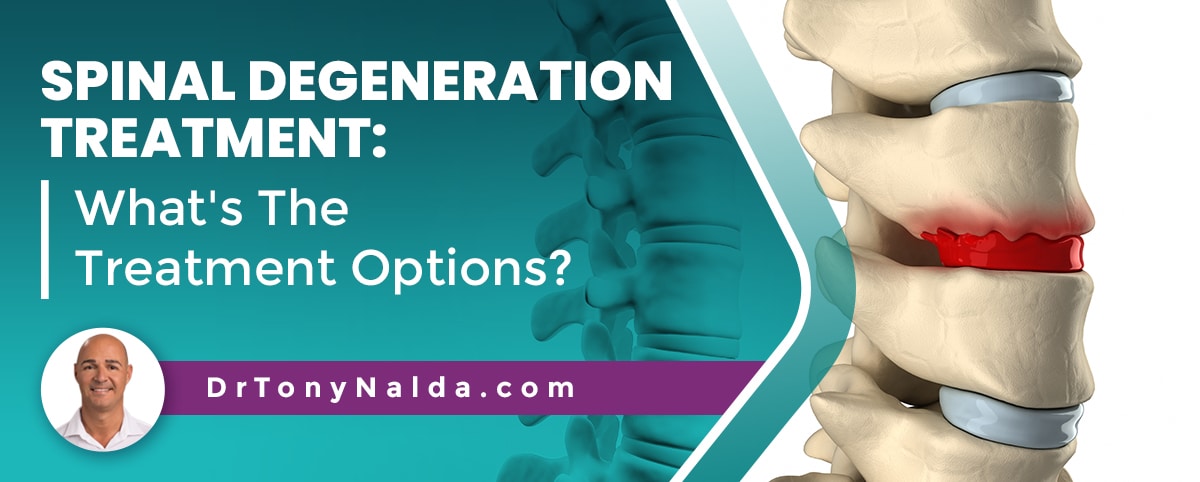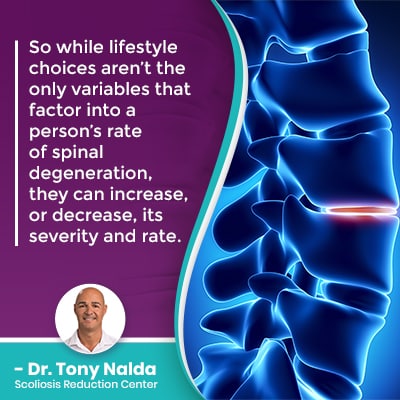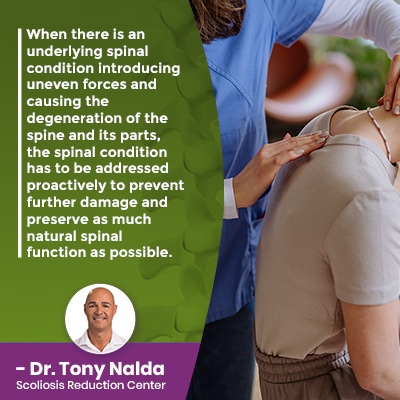Spinal Degeneration Treatment: What's The Treatment Options?

As we age, the body experiences degenerative changes, and the spine is no exception. While a certain degree of spinal degeneration is to be expected, other factors such as negative lifestyle choices, and/or the development of a spinal condition, can be the underlying cause of the degeneration. Continue reading to learn more about the most common causes of spinal degeneration, and what can be done about it.
When it comes to spinal degeneration treatment, the level of degeneration, and its cause, shape the design of effective treatment plans. The goal of treatment is to preserve as much of the spine’s natural strength and function as possible, and the first step is determining the underlying cause.
Before getting to the specific causes of spinal degeneration, let’s first take a look at some basic spinal anatomy, as some spinal structures deteriorate faster than others.
Table of Contents
Spinal Anatomy
The spine performs many important roles; it helps us to stand upright, practice healthy posture, engage in flexible movement, protect important organs, and the spinal cord partners with the brain to form the central nervous system (CNS).
The central nervous system is a complex communication network that facilitates brain-body communication, so is involved in the function of virtually every working system within the body.
The spine consists of vertebrae (bones of the spine) that are stacked on top of one another in a straight and neutral alignment, and when the spine is aligned, its natural curves are also in place.
The spine’s natural and healthy curves make it stronger, more flexible, and better able to handle mechanical stress incurred during activity.
In order for the spine to perform optimally, its natural curves and alignment need to stay in place.
Now, I’d like to talk about the spine’s intervertebral discs, as these are generally the first spinal structures to feel the effects of degenerative changes.
Discs of the Spine
As mentioned, the spine consists of vertebrae stacked on top of one another, and adjacent discs are separated by an intervertebral disc.
The spinal discs are key structures that have many important roles to play: providing the spine with structure (adjacent vertebrae attach to the disc in between), flexibility, cushioning so vertebrae don’t experience friction during activity, and acting as the spine’s shock absorbers.
The spinal discs consist of two main structures: a soft gel-like inner nucleus and a tough and durable outer annulus.
Considering the many roles the discs play in spinal health and function, it’s understandable that they are often the first spinal structures to feel the effects of degeneration.
Degenerative disc disease can cause a disc to become desiccated and change shape, which affects the position of adjacent vertebrae, so can cause the spine to become misaligned.
If a disc further deteriorates, it can become a bulging or herniated disc, and this can cause further problems.
Another reason the discs are generally the first spinal structures to start to deteriorate is because they don’t have their own vascular supply; in fact, the spinal discs are the largest structures in the body without a vascular supply.
As the discs have no direct path through which nutrients and oxygen needed for repair can pass, they absorb what they can from their surroundings, but this is why disc degeneration is difficult, if not impossible, to reverse.
So now that we’ve explored some basic spinal anatomy, plus why the spinal discs are particularly vulnerable to degenerative changes, let’s move on to the most common causes of spinal degeneration which are age, lifestyle, and underlying spinal conditions.
Age, Spinal Degeneration, and Lifestyle
Over time, and with increasing age, the body will experience degenerative changes, and when it comes to the spine, while there is a natural level of degeneration to be expected with age, certain lifestyle factors can increase the level, and rate, of deterioration.
For those interested in a preventative approach to preserving spinal health and function, awareness of lifestyle choices that affect the spine is key.
Maintaining a healthy weight is key because carrying excess weight puts pressure on the body’s joints, including the joints of the spine, and this is going to make them wear out faster as they are more strained on a daily basis.
As the very design of the spine is based on movement, leading a sedentary lifestyle is contrary to that design, and it’s through movement, and increased circulation, that discs can maintain their fluid levels and the spine and its surrounding muscles stay strong and healthy.
Consuming excessive amounts of alcohol and smoking can also contribute to spinal degeneration as it can contribute to disc desiccation and impacts a person’s overall health.
Repeatedly lifting heavy objects incorrectly can expose the spine to uneven wear and tear, straining it, and making it more vulnerable to injury.
Practicing good posture is also important because chronic poor posture puts the spine in unnatural positions, and over time, this can affect the position of certain vertebrae.
 So while lifestyle choices aren’t the only variables that factor into a person’s rate of spinal degeneration, they can increase, or decrease, its severity and rate.
So while lifestyle choices aren’t the only variables that factor into a person’s rate of spinal degeneration, they can increase, or decrease, its severity and rate.
Spinal Conditions
In addition to natural age-related spinal degeneration, and the cumulative effect of certain lifestyle choices, spinal degeneration can also be caused by the presence of an underlying spinal condition, of which there are many.
Spinal conditions such as scoliosis, kyphosis, and lordosis involve the development of an unnatural spinal curve, and when the spine loses its healthy curves, its biomechanics, function, and strength, are disrupted.
Conditions that introduce uneven forces to the spine can cause spinal degeneration because its ability to evenly absorb and distribute mechanical stress is disrupted, meaning the spine will experience uneven wear and tear.
Arthritic conditions such as osteoarthritis and osteoporosis involve a loss of the spine’s cartilage; cartilage protects bones and enables smooth gliding motion of the joints during movement, so if it erodes, friction becomes a problem, causing weaker bones that are more vulnerable to injury and further deterioration.
Treatment for Spinal Degeneration
As mentioned earlier, in order to effectively treat spinal degeneration, its underlying cause has to first be determined.
If a person is simply prescribed pain medication, while this can help with inflammation and short-term pain relief, this is only addressing a symptom of spinal degeneration (the pain), and not its cause.
In order to achieve long-term sustainable treatment results, the cause of the spinal degeneration has to be impacted proactively.
I say proactively because when it comes to spinal degeneration, the longer it’s left untreated, the worse it’s likely to get.
Here at the Scoliosis Reduction Center, I have years of experience treating a wide range of spinal conditions, including working towards preventing further spinal degeneration and preserving as much of the spine’s natural function and strength as possible.
So when the spine is deteriorating due to disc issues, preserving disc health, and preventing further damage, has to be the focus of treatment, and this can be worked towards through a combination of condition-specific chiropractic care and physical therapy.
Through chiropractic care that involves manual adjustments, I can work towards repositioning affected vertebrae to take pressure off the disc in between, and through physical therapy, I can increase core strength so the spine is better supported, and improve the circulation around the affected disc so it can absorb what’s needed for its repair/restoration.
While a certain degree of disc degeneration can be reversed, just as it develops slowly over time, the process of reversing it can also be lengthy.
 When there is an underlying spinal condition introducing uneven forces and causing the degeneration of the spine and its parts, the spinal condition has to be addressed proactively to prevent further damage and preserve as much natural spinal function as possible.
When there is an underlying spinal condition introducing uneven forces and causing the degeneration of the spine and its parts, the spinal condition has to be addressed proactively to prevent further damage and preserve as much natural spinal function as possible.
When spinal conditions have caused it to develop unhealthy curves, a curvature reduction can be worked towards through chiropractic care, corrective bracing, physical therapy, and rehabilitation.
When an arthritic condition is causing spinal degeneration, anti-inflammatory medications can help, along with physical therapy to help ensure the spine is receiving optimal support from its surrounding muscles.
Conclusion
When it comes to preventing spinal degeneration, leading a spine-friendly lifestyle is key, and this involves maintaining a healthy weight, activity level, practicing good posture, and properly lifting heavy objects by engaging the legs, rather than straining the back.
Most often, it’s the spinal discs that are the first spinal structures to feel the effects of degeneration, so disc issues such as disc desiccation, bulging, and or herniated discs are the root cause of many cases of spinal degeneration.
Here at the Center, I treat cases of spinal degeneration by first determining its underlying cause; this is the difference between treating a symptom of spinal degeneration, or the spinal degeneration itself, by addressing its underlying cause.
Dr. Tony Nalda
DOCTOR OF CHIROPRACTIC
After receiving an undergraduate degree in psychology and his Doctorate of Chiropractic from Life University, Dr. Nalda settled in Celebration, Florida and proceeded to build one of Central Florida’s most successful chiropractic clinics.
His experience with patients suffering from scoliosis, and the confusion and frustration they faced, led him to seek a specialty in scoliosis care. In 2006 he completed his Intensive Care Certification from CLEAR Institute, a leading scoliosis educational and certification center.
About Dr. Tony Nalda
 Ready to explore scoliosis treatment? Contact Us Now
Ready to explore scoliosis treatment? Contact Us Now





